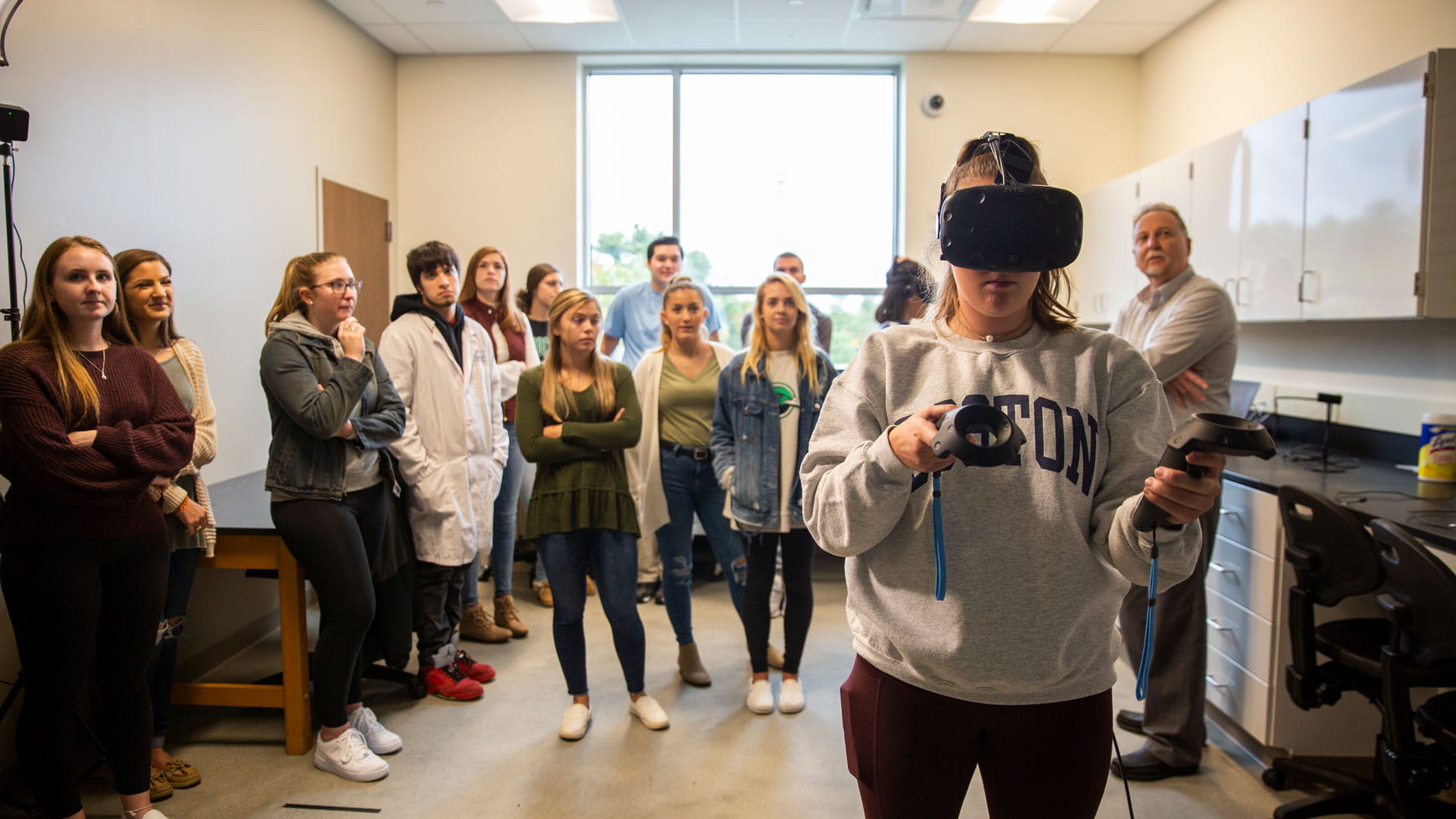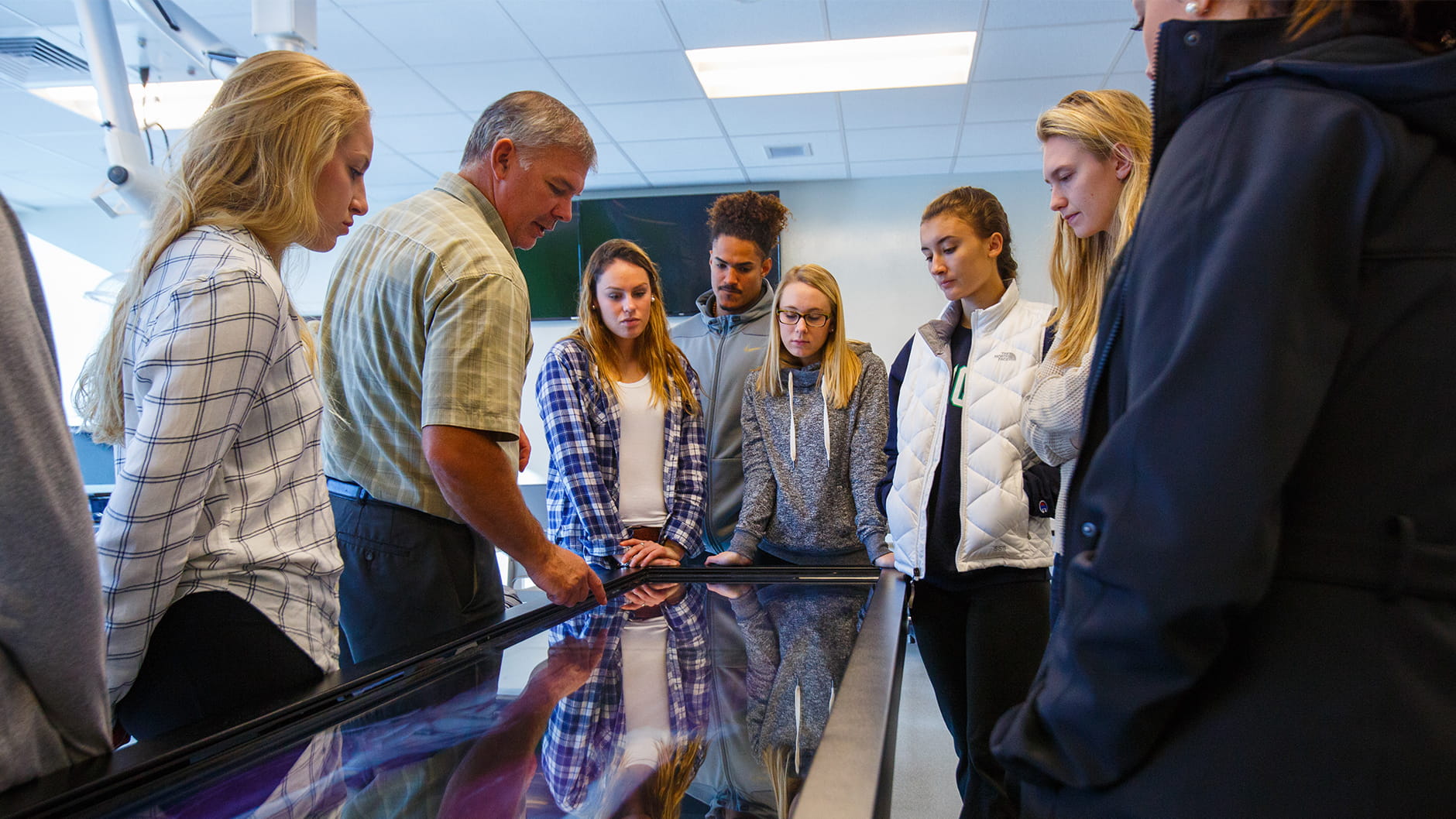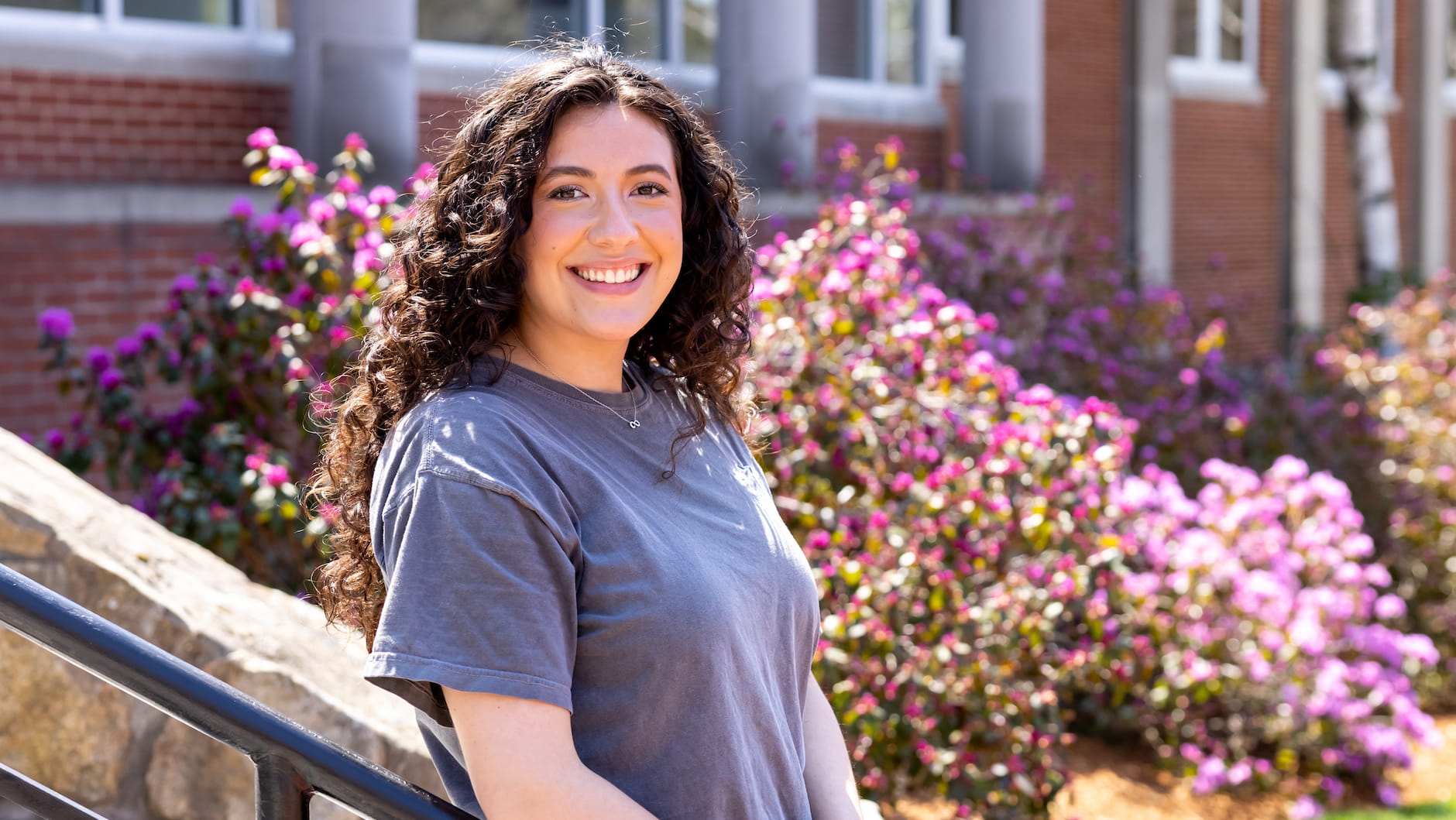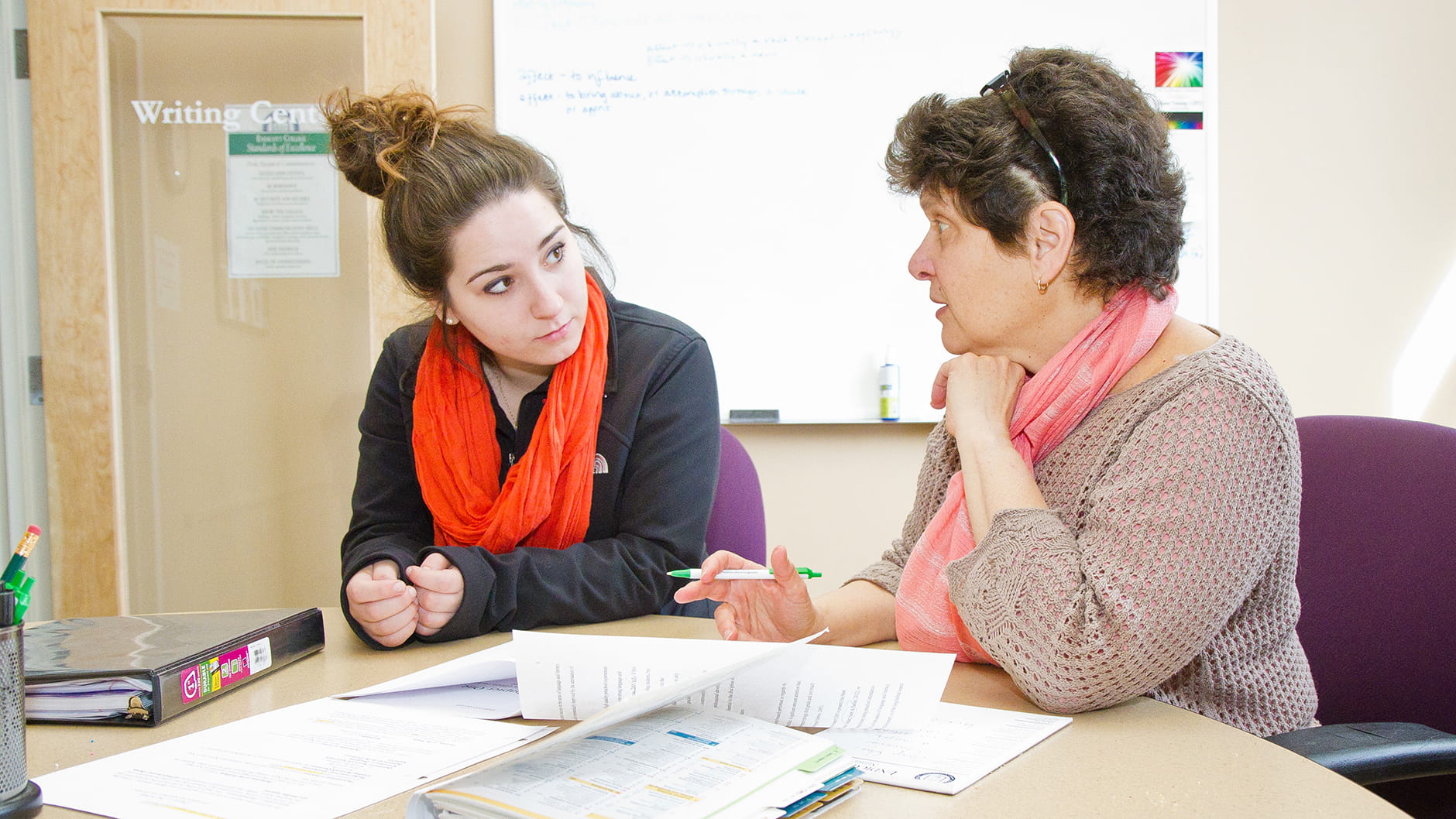Academics
Read Time: … min
https://enscape3d.com/So far, this year has not been quite what we expected. We are not living the Blade Runner life. We have not even reached the 1985 standard of a decent hoverboard like Back to the Future expected. However, technology has moved forward in ways that we never could have expected. And, much of that innovative technology is being used most actively on college campuses by students. Here are some surprising ways our Endicott College students are using it.
She says, “VR brings the students into their own designed spaces and allows them to pre-explore their user’s experience. They find out how their design dimensions feel. It places real emphasis on the clearance and heights in the drawings. VR helps to bring attention to their way-finding in their design much more than if they use just a floor plan.”
The use of VR in an interior architecture program is very practical, as it is the emerging standard in interior architectural presentations to real-world clients. This preparation that the technology provides students will translate directly into job-preparedness.
Hester Tinti-Kane is utilizing augmented reality (AR) in her social media class by asking her students to create Snapchat filters. She has also hosted Senior Instructional Technologist, Hedrick Ellis as a guest speaker in her Media and Culture class where they looked at how VR is impacting modern journalism.
She says, “XR (the umbrella term for augmented, virtual, and mixed reality) is an evolving new medium that is starting to impact the work of marketers and media professionals around the world. It was great to work with Ellis and bring these technologies directly to my students so they could experience them and think about how they might use them in their class projects, internships, and future careers.”
She says, “We started using VR to train our goalies this semester as soon as the technology became available. This is something I’m passionate about, and I have been looking for cost-effective ways to use it for my program. Currently (or until recently) we have been doing weekly sessions with our goalies. Hand eye, reaction time, and following go/no-go cues are very important in all sports, but especially for goalies.
“We use the Oculus for hand speed, hand-eye coordination, and cognitive training. The most useful game we have found thus far is the hockey goalie training, that helps them specifically react to different stimuli. For example, if the ball comes out red, they stop it with their right hand; if it comes out blue, they block it with their left.
“This is a fun and engaging way to train our most important muscle: the brain.”
Assistant Director, Field-Based Experiences, Kristen DiGiovanni, M.Ed says, “Mursion rolled out this past fall as a way to help our pre-practicum students practice classroom management and get exposure to parent-teacher conferences. Mursion also serves as an extension of Lynne Stasiak’s Classroom Management course. We use protocols for the observations to help with feedback and debriefing. Lynne, Julie, and myself also take part in the debriefing.
“Mursion offers low stakes practice and provides a common experience for each student, so that we can really debrief and unpack what happened during the simulations. It also teaches our students how to give and receive feedback, which is huge in the field of education.
Though it is currently being used just for our junior pre-practicum students, it will be piloted online as we move toward online courses, and we are excited for that future use.
Dean, School of Nursing, Nancy Meedzan says, “The richness of simulation learning enables student nurses to develop, synthesize, and apply their knowledge in life-like situations.”
Shaw says, “Students were so enthusiastic after using the anatomage table for cadaver dissection and exploring healthy and diseased organs from inside with the Sharecare virtual reality software that they asked for more time with the technologies. From a teaching perspective, those experiences engaged and motivated students in ways I have not seen before.”
Ellis says, “The professionals in health care and architecture fields are using VR more and more. Students’ experience with the technology at Endicott will help them prepare for these careers.
“As the price of the VR headsets comes down, students could experience remote learning in VR and recreate the feel of being in the same room with someone else. Magic Leap also has a distance collaboration feature. I've never heard more ‘oohs,’ and ‘aaaahs’ in an education environment than when people put on a VR headset for the first time. Since it's not a consumer product yet, Endicott is opening up a new world to many students.”
Graduate Interior Architecture
Director of Interior Architecture Programs, Myoung Joo Chun started utilizing virtual reality (VR) in the winter 2020 semester. Traditionally, interior architecture students are required to build interior mockups as still images from their floor plans to showcase their work, but this year, Chun added an element by having them create virtual tours of the space that were fully immersive for the students and their audiences.She says, “VR brings the students into their own designed spaces and allows them to pre-explore their user’s experience. They find out how their design dimensions feel. It places real emphasis on the clearance and heights in the drawings. VR helps to bring attention to their way-finding in their design much more than if they use just a floor plan.”
The use of VR in an interior architecture program is very practical, as it is the emerging standard in interior architectural presentations to real-world clients. This preparation that the technology provides students will translate directly into job-preparedness.
Communication
Two of our adjunct communications faculty members are actively using next-level technology in their courses. For instance, John Donovan is offering a course called Next Generation Storytelling where students use tools such as Thinglink to create immersive 360 VR experiences.Hester Tinti-Kane is utilizing augmented reality (AR) in her social media class by asking her students to create Snapchat filters. She has also hosted Senior Instructional Technologist, Hedrick Ellis as a guest speaker in her Media and Culture class where they looked at how VR is impacting modern journalism.
She says, “XR (the umbrella term for augmented, virtual, and mixed reality) is an evolving new medium that is starting to impact the work of marketers and media professionals around the world. It was great to work with Ellis and bring these technologies directly to my students so they could experience them and think about how they might use them in their class projects, internships, and future careers.”
Athletics
Even when the field is wet or in use, athletes can use VR technology. For instance, at Endicott, our women’s lacrosse coach, Maureen Spellman has already begun to use it with her players and plans to incorporate it into regular training sessions for her goalie.She says, “We started using VR to train our goalies this semester as soon as the technology became available. This is something I’m passionate about, and I have been looking for cost-effective ways to use it for my program. Currently (or until recently) we have been doing weekly sessions with our goalies. Hand eye, reaction time, and following go/no-go cues are very important in all sports, but especially for goalies.
“We use the Oculus for hand speed, hand-eye coordination, and cognitive training. The most useful game we have found thus far is the hockey goalie training, that helps them specifically react to different stimuli. For example, if the ball comes out red, they stop it with their right hand; if it comes out blue, they block it with their left.
“This is a fun and engaging way to train our most important muscle: the brain.”
Education
If you haven’t heard about Mursion, it’s a pretty incredible VR program that is focused on training. Endicott started using Mursion in Fall 2019 to help train future educators.Assistant Director, Field-Based Experiences, Kristen DiGiovanni, M.Ed says, “Mursion rolled out this past fall as a way to help our pre-practicum students practice classroom management and get exposure to parent-teacher conferences. Mursion also serves as an extension of Lynne Stasiak’s Classroom Management course. We use protocols for the observations to help with feedback and debriefing. Lynne, Julie, and myself also take part in the debriefing.
“Mursion offers low stakes practice and provides a common experience for each student, so that we can really debrief and unpack what happened during the simulations. It also teaches our students how to give and receive feedback, which is huge in the field of education.
Though it is currently being used just for our junior pre-practicum students, it will be piloted online as we move toward online courses, and we are excited for that future use.
Nursing
Nursing is integrating technology into many aspects of their teaching practices. Currently, they are using all aspects of Canvas, the Google Suite, and Zoom to deliver both didactic and clinical content virtually to our students. In addition, Associate Dean, Amy Smith has collaborated with the full-time faculty to develop virtual simulations, which will be used to replace clinical hours.Dean, School of Nursing, Nancy Meedzan says, “The richness of simulation learning enables student nurses to develop, synthesize, and apply their knowledge in life-like situations.”
Other Technology on Campus
In December, we spoke with Professor, Biology, Joyce Shaw about her scientific use of technology in the classroom. She is utilizing “Sharecare VR” to show students the inside of organs, and is regularly using an anatomage table that was acquired in 2014 via a grant from the Evelyn Lilly Lutz Foundation at Beverly Hospital. The table allows for virtual dissections using high-resolution images of the body’s systems. It is truly incredible how much more immersive the table and program are in teaching systems that are important to nursing students, and many others who are interested in the sciences.Shaw says, “Students were so enthusiastic after using the anatomage table for cadaver dissection and exploring healthy and diseased organs from inside with the Sharecare virtual reality software that they asked for more time with the technologies. From a teaching perspective, those experiences engaged and motivated students in ways I have not seen before.”
Options for All
The use of Endicott’s campus technology is not exclusive. Faculty, staff, and students can all experience it as long as they make an appointment through Academic Technology. Currently, we offer all of the following technological tools:
Virtual Reality (VR)
Hardware:
- Google Cardboard
- Oculus Go
- Oculus Rift
- Oculus Quest
- HTC Vive
- 360 cameras that can be used to create VR content
Software:
- Sharecare VR
- Enscape
- Goaltender VR
- BBC: 1943 Berlin Blitz
- Mondly
- Rich’s Plank Experience
- Organon
- Mission ISS
- Google Tour Creator
Mixed Reality
Two Magic Leap One devices
Augmented Reality
iPads are the main hardware we use, but we also have a dedicated tripod for making the iPad easier to use for AR and Merge Cube, which can add to the experience.
The Future
This year’s technological outlook is bright. Associate Professor, Computer Science, Michael Ocean, plans to hold a course next fall focused on teaching Unity, a widely-used VR authoring software; adjunct faculty member, Mary Hatton is going to use VR with her Science Methods course to have pre-service teachers explore how they might use VR with elementary students; and our Business, Nursing, and Hospitality schools are considering integrating Mursion into their curriculums.Ellis says, “The professionals in health care and architecture fields are using VR more and more. Students’ experience with the technology at Endicott will help them prepare for these careers.
“As the price of the VR headsets comes down, students could experience remote learning in VR and recreate the feel of being in the same room with someone else. Magic Leap also has a distance collaboration feature. I've never heard more ‘oohs,’ and ‘aaaahs’ in an education environment than when people put on a VR headset for the first time. Since it's not a consumer product yet, Endicott is opening up a new world to many students.”



